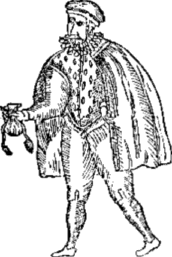A cutpurse
When daffodils begin to peer,
With heigh the doxy* over the dale,
Why, then comes in the sweet o'the year
For the red blood reigns in the winter's pale*.
The white sheet bleaching on the hedge,
With heigh the sweet birds, O how they sing!
Doth set my pugging tooth on edge,
For a quart of ale is a dish for a king.
Thus Autolycus announces his membership in the fraternity of vagabonds, as he enters in The Winter's Tale (4.3.1-8). He sells trinkets and ballads--and cuts purses at the Shepherd's sheep-shearing festival, an activity he says himself would be punished by hanging. Yet he is a wonderful and sympathetic stage presence, by no means a villain.
The laws of "figging," or villainy*.
Footnotes
-
Pale Doxies?
- Doxy
- A prostitute (click for more).
- Pale
- Literally a fence or enclosure, but there is also a pun on winter's pale complexion.
-
Greene's "figging law"
"Figging law"--one of the "eight laws of villainy" revealed in Robert Greene's pamphlet, A Notable Discovery of Cozenage--covers the activities of cutpurses and pickpockets. Greene offers a dictionary of their terms:
"The cutpurse, a nip;
He that is half with him, the snap;
The knife, the cuttle-bung;
The pickpocket, a foin;
He that faceth the man [acts as a decoy], the stale;
Taking the purse, drawing;
Spying of him, smoking;
The purse, the bung;
The money, the shells;
The act doing, striking."
